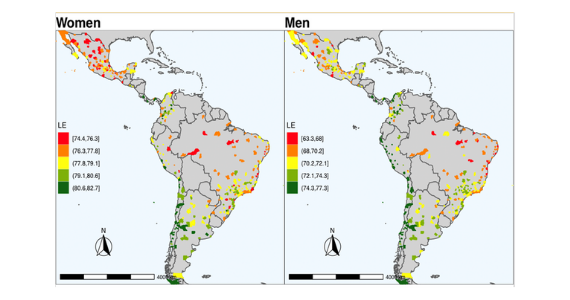Where you live matters: Life expectancy and causes of death in Latin American cities
New research from SALURBAL sheds further light on inequalities in life expectancy and causes of death in Latin American cities.
Posted on
January 25, 2021
Por: Katy Indvik
SALURBAL Project
For a long time, researchers and policymakers have assumed that people who live in cities are healthier than people living in rural areas. This so-called “urban advantage” is usually attributed to higher overall access and levels of healthcare, sanitation, education, and safety in urban areas – factors which contribute to longer average life expectancies for urban residents.
But averages only tell one part of a story. Previous research led by the SALURBAL project highlighted shocking differences in life expectancy between neighborhoods in six Latin American cities. The 2019 study, published in the Lancet Planetary Health, revealed that people living in some areas had life expectancies as much as 18 years less than people living in other areas, and that socioeconomic status played an important role in predicting these differences.
New research from SALURBAL published in Nature Medicine tells us more about critical inequalities across Latin American cities. The study examines differences in life expectancy and causes of death for 363 cities in 9 countries. Major gaps can be observed both within individual countries and across the region. Examining these differences can help us understand which city characteristics play a role in determining life expectancy and causes of death. These insights can support planning and decision-making processes to promote urban health.
Who lives the longest in Latin America?
The study reveals shocking differences in life expectancy across cities in Argentina, Brazil, Chile, Colombia, Costa Rica, Mexico, Panama, Peru, and El Salvador. For women living in cities in these countries, life expectancy can vary by more than 8 years (from 74.4 years to 82.7 years); for men, this difference can be as high as 14 years (from 63.5 years to 77.4 years). These variations are observed both between countries, and within countries – raising important questions about the impacts of national and subnational policies and management designed to promote health.
“We found that cities on the higher end of longevity in Latin America have life expectancies similar to those of high-income countries. On the other end, some cities had life expectancies similar to lower-middle-income countries, especially in men”
Usama Bilal, lead author on the new Nature Medicine study

Spatial distribution of life expectancy at birth by city in 363 Latin American cities.
What about causes of death?
The study also looked at the most significant causes of death, and how these causes vary across cities and countries. Death from violent and unintentional injury varied most between different cities in the same country. In particular, the proportion of all deaths due to violence varied drastically, ranging from less than 1% to as high as 20% across cities. The importance of other causes of death such as communicable diseases, maternal, neonatal and nutritional causes, and noncommunicable diseases like cancer and heart disease varied most between different countries.

Variability in proportionate mortality in 363 Latin American cities by country. Each column is a city, with each color representing the proportion of deaths due to each cause. Cities are grouped into countries. Countries are sorted by the overall proportion of violent deaths in the country and cities are sorted within country by the proportion of violent deaths in each city.
What factors affect life expectancy?
We are also learning more about which city characteristics affect life expectancy, and what aspects of a city might change people’s risk of dying by a particular cause. The results of this study suggest that people have higher life expectancy in cities where residents have higher overall education levels, better access to water and sanitation services, and experience less overcrowding. These urban factors (summarized in the figure below as the “social environment index”) can also affect causes of death – in these same cities with higher social environment index scores, communicable, maternal, neonatal and nutrition-related deaths become less significant, but cancer, heart disease, and other noncommunicable diseases become more important. More research is required to understand how people’s behavior and other health risks play a role in determining these differences.

Social environment index and proportionate mortality by five causes in 363 Latin American cities. The range of the horizontal axis goes from the minimum to the maximum observed value of the social environment index. Ticks at the bottom of each plot represent observations (cities) with that value of the index. The white labels show proportionate mortality by each of the five causes by values of the social environment index (in five equal intervals).
The insights produced by this research represent another step towards assessing the impacts of urban and health policies and designing future interventions to promote health and health equity in Latin American cities and urban areas around the globe.
“Studies like this are important because they can help us to understand the health consequences of urban planning and urban social policy decisions. This evidence can guide policymakers to look beyond the healthcare sector to make decisions that improve health in cities.”
Ana Diez Roux, Principal Investigator of the SALURBAL project
To read the full article, published on January 25 2021, click here.
To access an interactive dashboard with data, maps and graphics from this study, click here.